Blog
Mortice Locks: types, installation and the best to buy in 2024
Introduction
Mortice locks are one of the most common locks used in commercial and private property. They are known for their durability and versatility and offer several layers of protection that mean they are the first choice for many locksmiths and trades people looking to provide a convenient and secure mechanism for both interior and exterior doors.
Whether you’re a property developer, estate agent, commercial property manager, or simply keen to understand more about how mortice locks work, this guide will give you a basic overview of what mortice locks are, explain the different types of mortice locks, describe how to install a mortice lock, and look at some of the best mortice locks available in 2024.
We always recommend that a locksmith or security professional fits your mortice locks but this guide will help you understand what can be a technical and unfamiliar topic.
In this article
What is a mortice lock?
Types of mortice locks
Choosing the right mortice lock
Mortice lock installation guide
Maintaining and troubleshooting mortice locks
Mortice lock safety and security tips
Further reading
FAQs about mortice locks
To begin with, let’s look at what a mortice lock is and how it compares to other locking mechanisms.
What is a mortice lock?
A mortice lock is a secure locking mechanism that is installed into a pocket, or ‘mortice’, cut into the edge of a door.
A mortice lock comes in two parts – the main body of the lock which contains the locking mechanism, and a strike plate which houses a cavity to hold the locking bolt – technically known as a deadbolt. The main body of the lock is inserted into the edge of a door, and the strike plate is fixed to the door frame so that the cavity aligns with the deadbolt.
Mortice locks are available in a range of variants. A mortice deadlock is shown below.
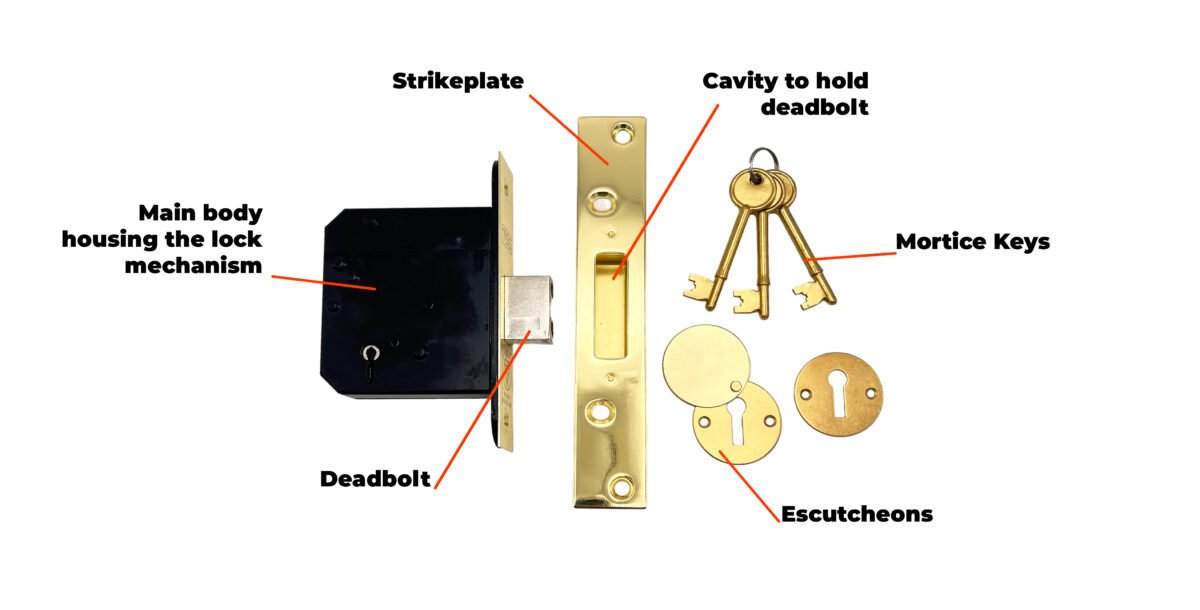
The lock is operated by inserting and turning a key. This engages a series of levers or detainers inside the mechanism which extend the deadbolt out into the cavity in the strike plate, ensuring that the door cannot be opened.
Mortice locks vs. other types of locks
Mortice locks are different from other common locks, such as cylinder locks and multipoint locks, in both design and application. Cylinder locks, for example, operate by a locking mechanism contained within the cylinder.
Because they are embedded into the body of a door, mortice locks are harder to tamper with and are generally more robust than other types of lock. So, they are ideal for doors requiring a higher level of security.
History and evolution of mortice locks
Examples of mortice-like locks can be found dating back to Roman times, but the modern mortice lock has its roots in medieval Europe, where rudimentary mortice locks were used to secure rooms containing valuable items in a home or castle. The mechanisms for these early mortice locks were fixed to the outside of the door and contained a series of wooden or metal blocks that could only be moved by a key cut into a specific shape. The blocks were referred to as wards and hence the locks became known as ‘warded locks’.
As technology progressed, the mechanisms were refined. In the early 19th century, Jeremiah Chubb was one of the names at the forefront of the development of lever tumbler locks. Later in the century, Linus Yale‘s mortice cylinder moved the bolt and the mechanism inside the door itself, producing a lock that more closely resembled the internal mechanism of today’s mortice locks.
Types of mortice locks
There are two core types of mortice locks – deadlocks and sashlocks – and within those two categories, you’ll find a range of different types, each suited to specific applications. Below, we look at some of the most common types, including their features, security benefits, and limitations.
Mortice Deadlock
A mortice deadlock is a basic but highly secure locking mechanism. It consists of a deadbolt that is operated by a key, providing a straightforward locking solution. Mortice deadlocks are usually used on doors with a separate handle or opening mechanism like a nightlatch.

A standard mortice deadlock only houses a deadbolt
Deadlocks are typically used on external doors like the main entry to a commercial premises, a home front door, or a garage or small storage facility.
Deadlocks provide varying levels of security depending on the number of levers they contain, however fitting a deadlock that meets BS3621 standards is recommended for enhanced security and for insurance purposes. Deadlocks are resistant to tampering and, because of their simple mechanism, they require little maintenance. So, they are an ideal solution for those in search of a simple but effective security solution.
Popular Mortice Deadlocks
TSS British Standard 5 Lever Mortice Deadlock
ERA Fortress British Standard 3621:2007 Mortice Deadlock
Union 2100 Strongbolt British Standard 3621:2007 Mortice Deadlock
Union 2134E British Standard 5 Lever Mortice Deadlock
(Ex Chubb) Union 3G114E British Standard 5 Lever Mortice Deadlock
Mortice Sashlock
A mortice sashlock is similar to a deadlock but includes an integrated latch mechanism as well as a deadbolt. This allows the door to be opened and closed without locking it each time. A mortice sashlock can be locked and unlocked using a key, but the latch itself can usually be operated by a handle.

A standard mortice sashlock houses a deadbolt and a latch mechanism
Mortice sashlocks offer the security of a deadlock when you need it but allow for easy opening of a door without using a key. That makes them a popular choice for internal doors or external doors where quick access may be needed.
As with deadlocks, the level of security provided by a sashlock is determined by the number of levers it contains. Sashlocks with 5 levers are typically used on external doors and 3 lever sashlocks are more commonly found on internal doors. For insurance compliance, ensure the sashlock meets BS3621 standards.
Popular Mortice Sashlocks
TSS British Standard 5 Lever Mortice Sashlock
ERA Fortress British Standard 3621:2007 Mortice Sashlock
Union 2200 Strongbolt British Standard 5 Lever Mortice Sashlock
Union 2234E British Standard 5 Lever Mortice Sashlock
Lever Mortice Locks
As the name suggests, lever mortice locks use levers inside the locking mechanism. These levers are positioned so that they must all be aligned in specific positions to open or close the deadbolt. This is done by turning a uniquely cut key. Once the levers are correctly aligned, the deadbolt can move in or out of the lock mechanism, allow the lock to be closed or opened.
Lever mortice locks are the most common mortice locks you will find, and the amount of security that they offer depends on the number of levers used in the mechanism.
Here are the inner workings and key components of a mortice lock:

1 – Bolt (BS locks feature a 20mm hardened bolt)
2 – Latch (sash locks feature a reversible latch that is withdrawn by the handle)
3 – Faceplate
4 – Forend
5 – Holes to accept bolt through furniture
6 – Spindle
7 – Levers (BS locks feature at least 5 levers with false notching)
8 – Keyway
9– Bolt thrower
Key measurements of a mortice lock include:
A – Centres
Seen on sashlocks only, this is the distance between the centre of the keyway and the centre of the spindle hole. This distance is typically 57mm
B – Backset
The most critical measurement on a mortice lock is the distance between the faceplate and the centre of the keyhole.
2 Lever & 2 Lever Rebated Mortice Locks
2 lever mortice locks are the simplest form of mortice locks, suitable for low-security internal applications. These locks are often used on internal doors that do not require substantial security.
2 lever mortice locks can also be found for rebated doors. These are doors with a stepped edge where one door overlaps the other – like double or French doors. The depth of this overlap, or rebate, is crucial when fitting mortice locks, so it’s essential to use a rebate kit if the mortice lock is not already rebated. These kits bridge the gap caused by the rebate, allowing the lock to function correctly and maintaining door security.
While not designed to withstand significant attacks, 2 lever mortice locks offer a basic level of security for non-critical areas inside a building or home.
Popular 2 lever & 2 lever rebated mortice locks
Legge 159/2378 2 Lever Mortice Sashlock
Union 2242 Rebated 2 Lever Mortice Sashlock
ERA 287/387 Rebated 2 Lever Mortice Sashlock
Yale PM246 2 Lever Mortice Sashlock
Union 2295 2 Lever Mortice Sashlock
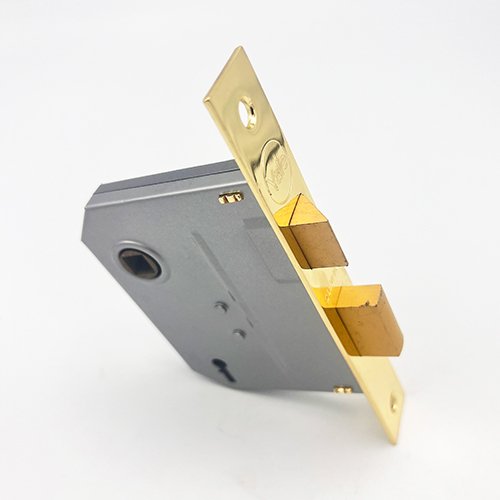
Yale PM246 2 Lever Mortice Sashlock
3 Lever Mortice Locks
3 lever mortice locks are designed for internal wooden doors, where high security is not essential. They are available as sashlocks or deadlocks and provide a practical solution for bedrooms and other internal areas. These locks don’t offer the same level of security as 5 or 6 lever locks, but they are sufficient for areas where lower security is acceptable and provide a balance of security and functionality.
Popular 3 lever mortice locks
Imperial G3000 3 Lever Mortice Sashlock
TSS 3 Lever Mortice Deadlock
ERA 472 3 Lever Mortice Deadlock
Union 2103 Strongbolt 3 Lever Mortice Deadlock
Yale PM320 3 Lever Mortice Sashlock

TSS 3 Lever Mortice Sashlock
5 and 6 Lever Mortice Locks
5 lever mortice locks and 6 lever mortice locks are robust security solutions for various door types.
While they offer the highest level of security among lever locks, they may still not qualify as BS3621 locks if they do not feature additional security features and meet the required testing standards. So, it’s important to check for BS3621 compliance if you are looking for an insurance-compliant solution.
These locks are available as both deadlocks and sashlocks and provide substantial security for residential and commercial properties.
Popular 5 and 6 lever mortice locks
Wellington Fort 4H 6 Lever Mortice Deadlock
Imperial G5000 Non British Standard 5 Lever Mortice Sashlock
TWH Legge Replacement 5511 Non British Standard 5 Lever 2″ Mortice Deadlock
Union 2234 Non British Standard 5 Lever Mortice Sashlock
Yale PM550 Non British Standard 5 Lever Mortice Sashlock
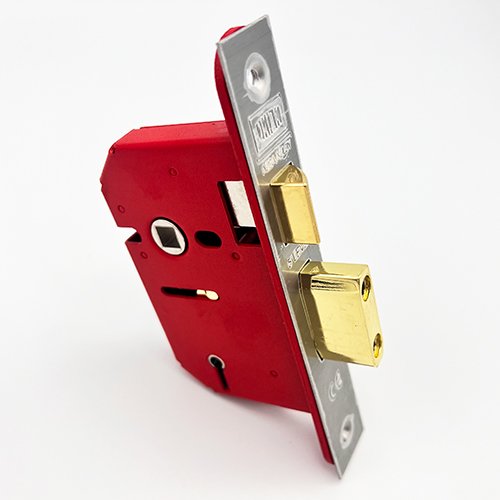
Union 2205 Strongbolt Non British Standard 5 Lever Mortice Sashlock
Detainer Mortice Locks
Detainer locks use a different mechanism to lever locks. Instead of having a series of levers within the lock, detainer locks have small metal discs or plates that are used to block (or detain) the lock mechanism and stop the lock from opening and closing. Inserting and turning a key will align those discs or plates so that the block is removed, and the lock can open freely.
Detainer mortice locks provide more advanced protection against picking and other forms of attack. That makes them an excellent choice for both residential and commercial properties where enhanced security is required.
Popular detainer mortice locks
(Ex Chubb) Union 3K70 Non British Standard 5 Lever Mortice Sashlock
(Ex Chubb) Union 3J60 Horizontal Non British Standard 5 Lever Mortice Sashlock
Union (ex Chubb) 3G135 Fortress Mortice Deadlock
(Ex Chubb) Union 3R35X Egress Non British Standard 5 Lever Mortice Deadlocking Latch
(Ex Chubb) Union 3R35 Non British Standard 5 Lever Deadlocking Mortice NightLatch
(Ex Chubb) Union 3G110 Non British Standard 5 Detainer Mortice Deadlock
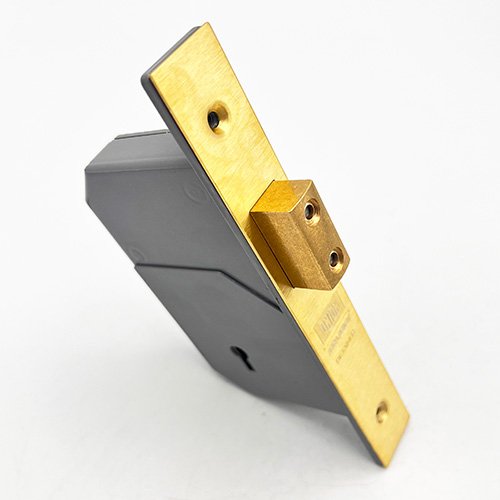
(Ex Chubb) Union 3G110 Non British Standard 5 Detainer Mortice Deadlock
British Standard Mortice Locks (BS3621)
The British Standards Institute (BSI) is a non-profit UK organisation that produces technical standards and certification for a wide range of products and services. When a product comes with British Standards certification, it offers customers the reassurance that the product has been made to the highest standards and is compliant with a range of strict safety, security or quality criteria.
BS3621 is the BSI standard which locks need to meet in order to comply with many home insurance policies. For that reason, British Standard Mortice Locks can be considered the ultimate in door security.
BS3621 locks can be deadlocks or sashlocks and will contain a minimum of 5 levers. They will also offer additional features like a deadbolt that extends out at least 20mm and hardened plates to prevent drilling attacks. These additional features provide superior protection and ensure compliance with insurance requirements, offering peace of mind to both private and commercial property owners.
Popular British Standard (BS3621) Mortice Locks
TSS British Standard 5 Lever Mortice Deadlock
ERA Fortress British Standard 3621:2007 Mortice Sashlock
Union 2100 Strongbolt British Standard 3621:2007 Mortice Deadlock
(Ex Chubb) Union 3G114E British Standard 5 Lever Mortice Deadlock
Eurospec Easi-T BS3621:2017 British Standard Mortice Sashlock
Legge 641/761 Value British Standard 5 Lever Mortice Deadlock

ERA Fortress British Standard 3621:2007 Mortice Sashlock
Bathroom Mortice Locks
Bathroom mortice locks are specifically designed for use on bathroom doors, and disabled toilet doors. They differ from standard mortice locks in that they will usually include a thumb turn on the lock so that the door can be locked from the inside without a key. Some models also include emergency access features, allowing someone to unlock the door from the outside in case of an emergency.
Popular bathroom mortice locks
NKS Reversible Disabled Bathroom Lockset (Radar Type) – designed specifically for use on disabled toilet doors.
TSS Bathroom Mortice Sashlock
Union 22WC Strongbolt Bathroom Mortice Sashlock
Union L2C27 Bathroom Mortice Sashlock
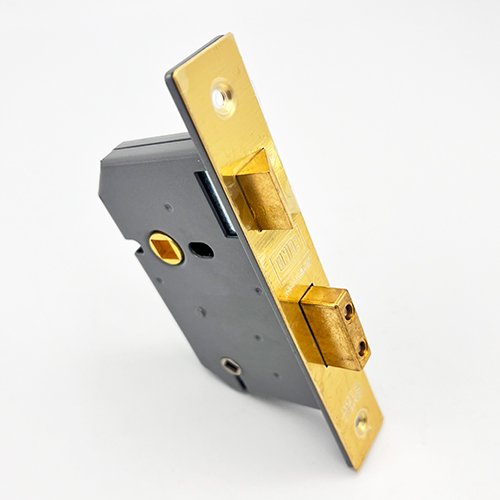
Union 2226 Bathroom Mortice Sashlock
Choosing the right mortice lock
When selecting a mortice lock, it’s essential to consider various factors, including your security needs, the type of door the lock will be fitted to, and the type of property where the lock will be used. Here are some considerations to help you make an informed decision.
Security needs
How important is security for the door you’re locking? For external doors where insurance compliance is required, opt for high-security 5 lever or detainer locks that meet British Standards (BS3621).
Door material
Most mortice locks are fitted to wooden doors. But you will occasionally find a situation where a lock needs to be fitted to a metal or uPVC door. In such cases, check with your supplier or locksmith to make sure the locks you are buying are suitable for those materials.How important is security for the door you’re locking? For external doors where insurance compliance is required, opt for high-security 5 lever or detainer locks that meet British Standards (BS3621).
Type of property
Residential
For residential home security, consider a 5-lever mortice deadlock or sashlock that meets BS3621 standards for external doors. For internal doors you could opt for a 2 or 3 lever sashlock that combines practicality with security.
Commercial
For commercial properties, higher-grade mortice locks may be required, depending on the door’s usage. Detainer mortice locks are a common choice for commercial buildings due to their enhanced security.
Common commercial mortice locks
(Ex Chubb) Union 3K70 Non British Standard 5 Lever Mortice Sashlock
(Ex Chubb) Union 3J60 Horizontal Non British Standard 5 Lever Mortice Sashlock
Union (ex Chubb) 3G135 Fortress Mortice Deadlock
(Ex Chubb) Union 3R35X Egress Non British Standard 5 Lever Mortice Deadlocking Latch
(Ex Chubb) Union 3R35 Non British Standard 5 Lever Deadlocking Mortice NightLatch
(Ex Chubb) Union 3G110 Non British Standard 5 Detainer Mortice Deadlock
Mortice lock installation guide
Installing a mortice lock requires precision and the right tools. We always recommend that mortice locks are installed by qualified locksmiths and security professionals. The guide below is intended to give insight into how the product is fitted but should not be used as an instructional reference.
Tools required
- Souber mortice jig
- Chisel
- Mallet
- Tape measure
- Drill and drill bits
- Screwdriver
- Mortice lock and key
Step-by-step installation
- Mark the Lock Position: Measure the lock’s height on the door edge and mark where the mortice lock will be installed.
- Cut the Mortice: Use the Souber mortice jig to cut out a pocket (mortice) in the edge of the door to fit the lock body.
- Cut the indent for the faceplate: Set the Souber jig to a shallower drill depth and cut an indent at the top and bottom of the mortice to house the lock’s faceplate. Square off the corners of the indent using the mallet and chisel.
- Drill for the keyhole: Drill through the door to create a keyhole on both sides of the door. Make sure they are aligned to the keyholes in the lock body.
- Fit the lock body: Insert the lock body into the mortice and ensure it fits snugly.
- Install the face plate: Secure the faceplate over the mortice with screws.
- Add the keyhole covers. Screw the keyhole covers in place on either side of the door.
- Fit the strike plate: On the door frame, mark where the strike plate will go and chisel a recess to fit it. Secure the strike plate with screws.
- Test the lock: Ensure the lock operates smoothly with the key.








